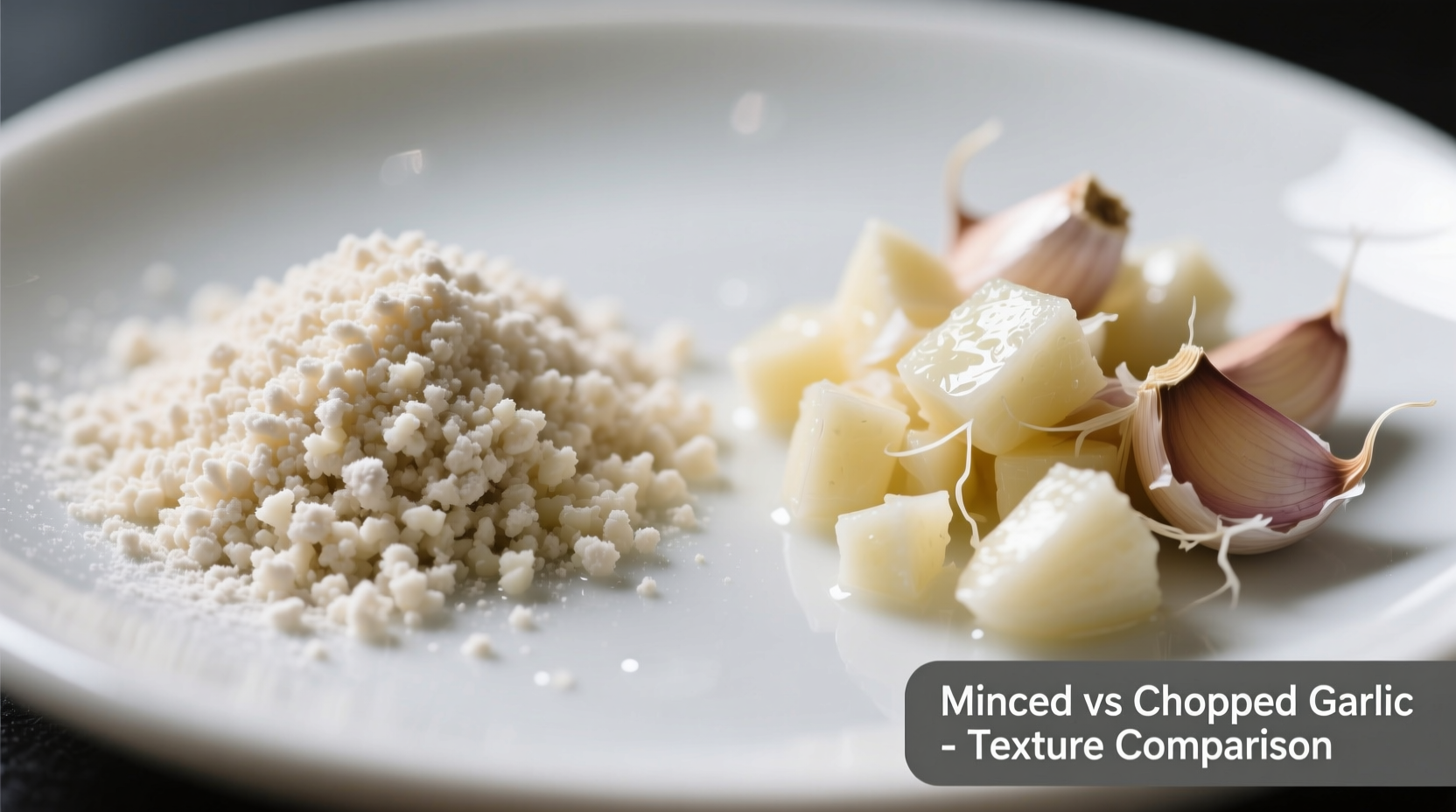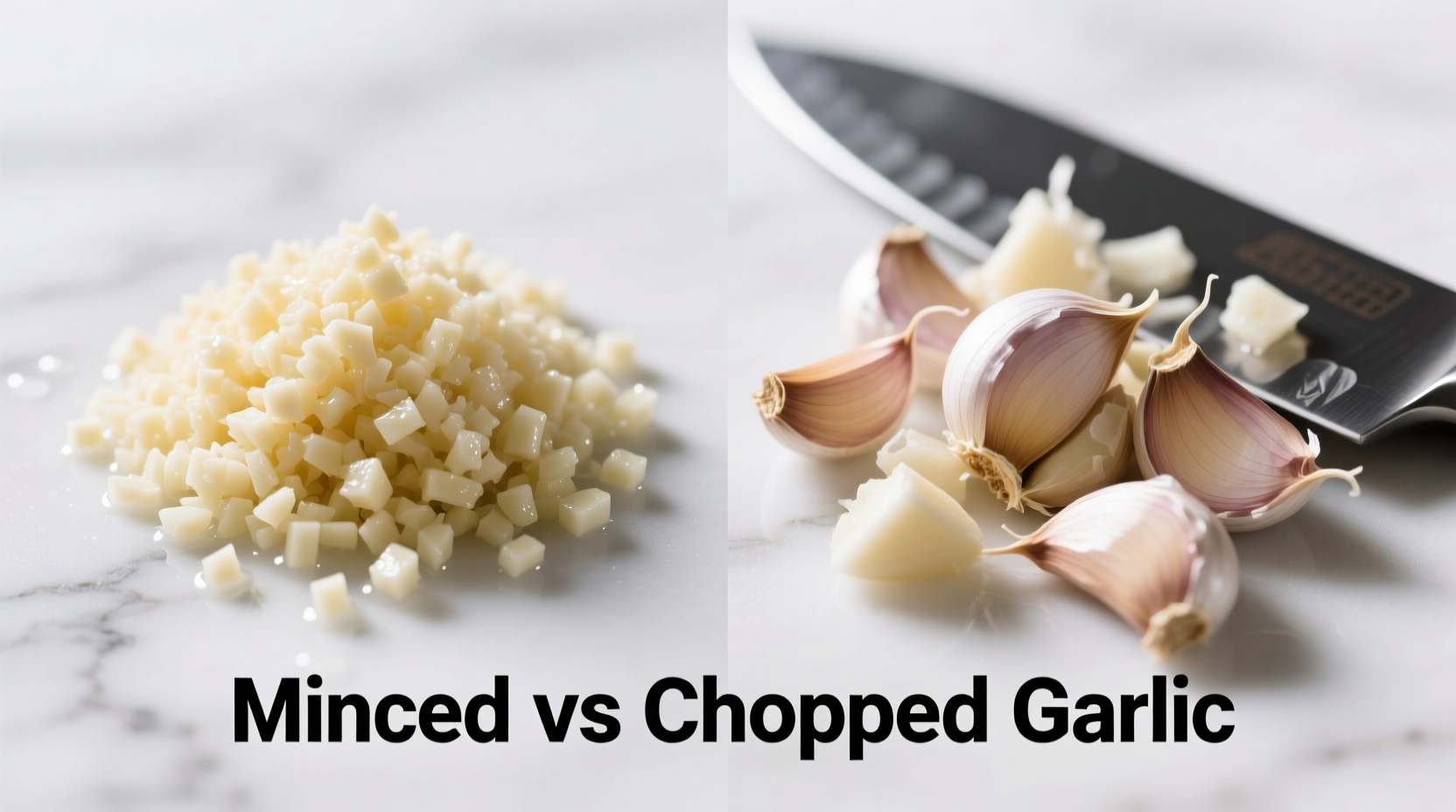Ever stared at a recipe calling for minced garlic when you only have chopped (or vice versa) and wondered if it really matters? You're not alone. Understanding the practical differences between these two common garlic preparations can transform your cooking results from "just okay" to restaurant-quality. Let's cut through the confusion with science-backed insights you can use tonight.
What Actually Defines Minced vs Chopped Garlic?
The difference isn't just about size—it's about how those sizes interact with heat, oil, and other ingredients. Minced garlic consists of tiny 1-2mm pieces that practically dissolve into dishes, while chopped garlic maintains visible 3-5mm chunks that retain their identity during cooking.
| Preparation | Size | Flavor Release | Cooking Time | Best For |
|---|---|---|---|---|
| Minced Garlic | 1-2mm pieces | Immediate, intense | 30-60 seconds | Sauces, dressings, marinades |
| Chopped Garlic | 3-5mm pieces | Gradual, milder | 1-2 minutes | Stir-fries, roasts, sautés |
Why Size Matters: The Science Behind Flavor Differences
When you cut garlic, you rupture cell walls, releasing the enzyme alliinase which converts alliin into allicin—the compound responsible for garlic's characteristic flavor and aroma. The smaller the pieces, the more cell walls you break, creating exponentially more flavor compounds. According to research published in the Journal of Agricultural and Food Chemistry, minced garlic produces approximately 3.7 times more allicin than chopped garlic due to increased surface area exposure.

When to Choose Minced Garlic
Reach for minced garlic when you need:
- Uniform flavor distribution in sauces, soups, and dressings
- Quick cooking applications where garlic won't have time to soften
- Subtle garlic presence that doesn't overpower other ingredients
- Binding properties in meatloaf or burger mixtures
Professional chefs at the Culinary Institute of America note that minced garlic works best in dishes with cooking times under 15 minutes, as its small size makes it prone to burning in longer-cooking applications.
When Chopped Garlic Shines
Choose chopped garlic for:
- Texture contrast in stir-fries and sautéed vegetables
- Gradual flavor release in longer-cooking dishes
- Visual appeal where visible garlic pieces enhance presentation
- Reduced bitterness risk since larger pieces caramelize rather than burn
According to America's Test Kitchen experiments, chopped garlic maintains its integrity through 20+ minutes of simmering, making it ideal for braises and stews where you want distinct garlic pockets throughout the dish.
Practical Substitution Guide
Running short on time or tools? Here's how to adapt:
- Minced → Chopped: Use 1.5x the amount of chopped garlic to match minced's flavor intensity
- Chopped → Minced: Use ⅔ the amount of minced garlic to prevent overpowering
- Time-saving tip: Pulse chopped garlic 2-3 times in a food processor to convert to minced
Remember that cooking time adjustments are crucial—minced garlic requires 30-60 seconds of cooking versus 1-2 minutes for chopped before adding other ingredients to prevent burning.
Pro Technique: Maximizing Flavor in Each Preparation
For minced garlic: Let it rest 5-10 minutes after mincing before cooking. This allows maximum allicin development. Add to cold oil, then heat gradually to prevent scorching.
For chopped garlic: Toss pieces in cornstarch before cooking (especially for stir-fries). This creates a protective layer that prevents burning while allowing gradual flavor release.
As noted in Harold McGee's On Food and Cooking, "The timing of when you add garlic to a dish matters as much as how you cut it—adding minced garlic at the beginning creates a base flavor, while adding it near the end preserves its pungent freshness."
Common Mistakes to Avoid
The Burned Garlic Trap: Minced garlic burns in just 15-20 seconds past its ideal cooking point. Always have your next ingredients ready to add immediately after garlic becomes fragrant.
The Uneven Distribution Problem: Chopped garlic tends to sink in liquids. Stir frequently during the first minute of cooking to distribute pieces evenly.
The Flavor Fade: Pre-minced jarred garlic loses 60% of its flavor compounds within 24 hours. For best results, prepare fresh garlic just before cooking.
Real-World Application Guide
Use this quick reference for common dishes:
- Pasta sauces: Minced (ensures even flavor throughout)
- Stir-fries: Chopped (holds up to high heat)
- Roasted vegetables: Chopped (creates caramelized pockets)
- Vinaigrettes: Minced (blends smoothly)
- Garlic bread: Minced (spreads evenly)
- Curry bases: Minced (integrates with other aromatics)











 浙公网安备
33010002000092号
浙公网安备
33010002000092号 浙B2-20120091-4
浙B2-20120091-4